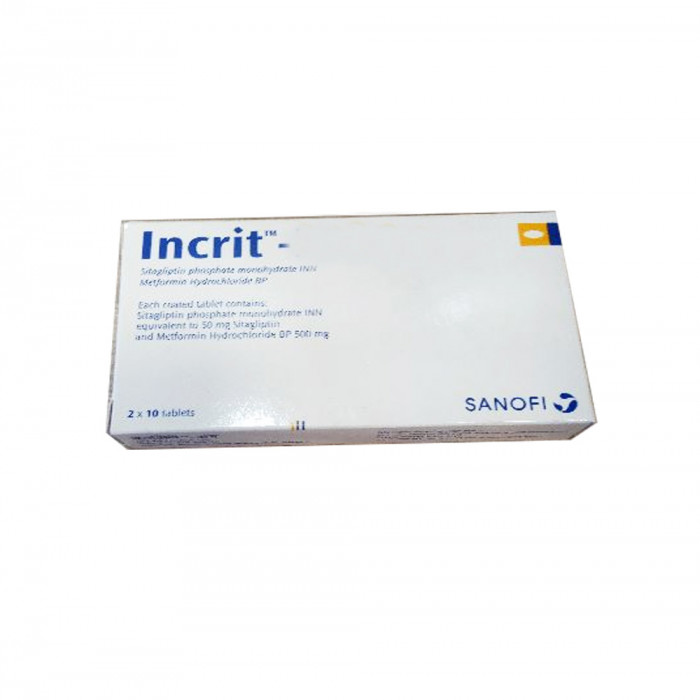
✔ 100% Authentic Product
👁️ Currently Viewing 1057
Incrit 100mg 10pcs
Tablet, Generic Name: Sitagliptin Phosphate Monohydrate INN, Manufacturer: Sanofi
Discount
Price: ৳ 283
MRP:
৳
301
6%
Off

100% Genuine Products, Guaranteed

Safe & Secure Payments, Always

Fast, Secure & Efficient Delivery

Proper Packaging
 Cash on Delivery - All over Bangladesh
Cash on Delivery - All over Bangladesh Regular Delivery - 12-24 Hours, Dhaka City* Charge Tk.39-59
Regular Delivery - 12-24 Hours, Dhaka City* Charge Tk.39-59 Regular Delivery - 24-48 Hours, Other Cities* Charge Tk.99-110
Regular Delivery - 24-48 Hours, Other Cities* Charge Tk.99-110
 ফ্রি ডেলিভারিঃ - ৯৯৯ টাকা+ অর্ডারে, ঢাকা
শহরে
ফ্রি ডেলিভারিঃ - ৯৯৯ টাকা+ অর্ডারে, ঢাকা
শহরে ফ্রি ডেলিভারিঃ - ২৯৯৯ টাকা+ অর্ডারে, ঢাকার
বাহিরে
ফ্রি ডেলিভারিঃ - ২৯৯৯ টাকা+ অর্ডারে, ঢাকার
বাহিরে
100% Genuine Products, Guaranteed
Safe & Secure Payments, Always
Fast, Secure & Efficient Delivery
Proper Packaging
 Cash on Delivery - All over Bangladesh
Cash on Delivery - All over Bangladesh Regular Delivery - 12-24 Hours, Dhaka City* Charge Tk.39-59
Regular Delivery - 12-24 Hours, Dhaka City* Charge Tk.39-59 Regular Delivery - 24-48 Hours, Other Cities* Charge Tk.99-110
Regular Delivery - 24-48 Hours, Other Cities* Charge Tk.99-110 ফ্রি ডেলিভারিঃ - ৯৯৯ টাকা+ অর্ডারে, ঢাকা
শহরে
ফ্রি ডেলিভারিঃ - ৯৯৯ টাকা+ অর্ডারে, ঢাকা
শহরে ফ্রি ডেলিভারিঃ - ২৯৯৯ টাকা+ অর্ডারে, ঢাকার
বাহিরে
ফ্রি ডেলিভারিঃ - ২৯৯৯ টাকা+ অর্ডারে, ঢাকার
বাহিরে
✅ Description:
Indications
Sitagliptin is used as a supplement to diet and exercise to enhance glycemic control in individuals with type 2 diabetes.
Important Use Restrictions: Sitagliptin should not be used in type 1 diabetes patients or for the treatment of diabetic ketoacidosis because it is ineffective in these situations. Patients with a history of pancreatitis have not been examined with sitagliptin. It is uncertain if individuals with a history of pancreatitis are at greater risk for the development of pancreatitis when taking Sitagliptin.
Pharmacology
Sitagliptin is a DPP-4 inhibitor that is thought to work in type 2 diabetes patients by delaying the inactivation of incretin hormones. Sitagliptin increases the concentrations of active intact hormones, which increases and prolongs the activity of these hormones. The gut releases incretin hormones throughout the day, including glucagon-like peptide-1 (GLP-1) and glucose-dependent insulinotropic polypeptide (GIP), and levels rise in response to a meal. DPP-4, an enzyme, quickly inactivates these hormones. The incretins are part of an endogenous system that regulates glucose homeostasis in the body.GLP-1 and GIP enhance insulin production and release from pancreatic beta cells through intracellular signaling pathways including cyclic AMP when blood glucose levels are normal or high. GLP-1 also inhibits the release of glucagon by pancreatic alpha cells, resulting in decreased hepatic glucose synthesis. Sitagliptin enhances insulin release and lowers glucagon levels in the circulation in a glucose-dependent manner by raising and prolonging active incretin levels. Sitagliptin inhibits DPP-4 activity in vitro but not DPP-8 or DPP-9 activity at concentrations similar to those found in therapeutic dosages.
Dosage & Administration
The recommended dose of sitagliptin is 50 mg twice a day and 100 mg once daily. Sitagliptin can be taken with or without food.
Interaction
Sitagliptin had no effect on the pharmacokinetics of metformin, glyburide, simvastatin, rosiglitazone, warfarin, or oral contraceptives.
Sitagliptin raises the mean Digoxin concentration by a little amount. However, neither drug's dose needs to be adjusted.
Contraindications
An allergic response to sitagliptin, such as anaphylaxis or angioedema, in the past.
Side Effects
Headache, upper respiratory tract infection, and nasopharyngitis are the most prevalent side effects. Patients using a combination of Sitagliptin and sulfonylurea with insulin may experience hypoglycemia.
Pregnancy & Lactation
Pregnancy Classification B. Rats and rabbits have been used in reproduction research. Because animal reproduction studies do not always anticipate human response, this medication should only be taken during pregnancy if absolutely necessary. Sitagliptin is released in a 4:1 milk-to-plasma ratio in nursing rats' milk. Sitagliptin is not known to be excreted in human milk. Because many medications are excreted in human milk, when sitagliptin is given to a breastfeeding woman, caution should be used.
Precautions & Warnings
If pancreatitis is suspected, sitagliptin should be stopped immediately and proper treatment started.
In patients with moderate or severe renal insufficiency, as well as those with ESRD who require hemodialysis or peritoneal dialysis, dosage adjustments are advised.
When sitagliptin is used in combination treatment with medicines that induce hypoglycemia, dose adjustments of sulfonylureas or insulin may be necessary to minimize the risk of hypoglycemia.
Hypersensitivity Responses: Serious hypersensitivity reactions have been reported in people using sitagliptin after it was approved for use. Anaphylaxis, angioedema, and exfoliative skin disorders such as Stevens-Johnson syndrome are among these responses. If a hypersensitive reaction is detected, stop taking sitagliptin, look for other possible reasons, and switch to another diabetic medication.
Storage Conditions
Store below 25°C, away from light, in a dry area. Keep medications out of the reach of youngsters in a secure location. Do not use beyond the expiration date. Only on a qualified physician's prescription can it be dispensed.
⚠️Disclaimer:
At ePharma, we’re committed to providing accurate and accessible health information. However, all content is intended for informational purposes only and should not replace medical advice from a qualified physician. Please consult your healthcare provider for personalized guidance. We aim to support, not substitute, the doctor-patient relationship.






